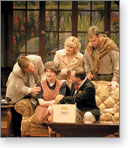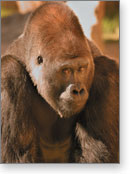|
|
| At Home In Omaha |
 Photos by Andy Daddio/Daddio Photography
Photos by Andy Daddio/Daddio Photography
Lewis and Clark’s legendary Corps of Discovery navigated the muddy waters of the mighty Missouri
River in 1804 to a spot where one day the city of Omaha, Nebraska, would arise. As they scratched
and paddled through horrific summer mosquito hatches and the river’s treacherous sandbars on
their way to the great Northwest, the last thing on their minds was what would be born and
still thriving 200 years hence on those banks.
They couldn’t have dreamed that in 2004 this city, hunkered down on America’s Great Plains,
would be a thriving metropolis of forward-thinkers, of Fortune 500 commerce, of arts lovers
and sports enthusiasts. They couldn’t have known this place would evolve into a city that
would coddle its own, and who would like nothing more than to invite the rest of the country
over for a visit.
 Omaha is a flourishing town of nearly 400,000. They supported the massive $2 billion
infrastructure development of the Riverfront district with as much verve and vitality as
they support their thriving and enthusiastic arts community. They’ve vitalized the crumbling
Old Market district because, well, it needed to be done, to preserve its legacy, for a cozy
few blocks of busy shops, a broad swath of dining pleasure and well-worn pubs that can be
called Omaha’s living room.
Omaha is a flourishing town of nearly 400,000. They supported the massive $2 billion
infrastructure development of the Riverfront district with as much verve and vitality as
they support their thriving and enthusiastic arts community. They’ve vitalized the crumbling
Old Market district because, well, it needed to be done, to preserve its legacy, for a cozy
few blocks of busy shops, a broad swath of dining pleasure and well-worn pubs that can be
called Omaha’s living room.
The community of Omaha supports eight major arts groups, and loves sports, though it can
only boast of one professional team, a farm club for the Kansas City Royals. Omaha adores
baseball, proven by its continuous community and city support of the NCAA College World
Series, held in town since 1955. And Omaha swings with more golf courses per capita than any
other city with a population over 100,000.
They’ve got all that and microbrews; two major universities and medical research facilities in
Creighton and the University of NebraskaOmaha; a newly completed Hindu temple; an alt-rock
music scene; a forward-thinking zoo; refurbished art deco buildings; a diverse population and
bragging rights as one of America’s best places to raise children.
 These things make them happy. They want these things because it makes life better out in
America’s breadbasket, where life sometimes can be hard, with winters that dip into the
miserable, summers that soar into the enervatingly humid, and a year-round wind that can chap
your hide into leather. And it’s still a place where you can sink your incisors into a mighty
fine piece of corn-fed beef.
These things make them happy. They want these things because it makes life better out in
America’s breadbasket, where life sometimes can be hard, with winters that dip into the
miserable, summers that soar into the enervatingly humid, and a year-round wind that can chap
your hide into leather. And it’s still a place where you can sink your incisors into a mighty
fine piece of corn-fed beef.
Take Lewis and Clark’s curiosity and intrepid nature with you when you come to Omaha. It’s a
place worth exploring, if for no other reason than to overcome a strange concept: Most people
don’t suffer from any misconceptions of the place. Most of us trundle along with no conception.
Says Mayor Mike Fahey, "One of the challenges that Omaha has faced is, how do we identify
ourselves. From my perspective, we’re a very exciting city, if in fact we can get people to
come and visit us. If you come to Omaha you’re going to be pleasantly surprised."
A good place to begin is at the river (where great explorers often start), standing on the
top deck of the riverboat River City Star. As it dawdles up and down the mighty Missouri, you
can imagine what Lewis and Clark saw: muddy water, brush-covered shore and miles of flatland
full of tall native grasses. But stretching out before your eyes is the gleaming newness of the
city. Omahans seem to love to look and plan for the future, but they can’t quite let go of the
past either.
 Tenth Street has seen the rise of the Riverfront development, from the ruins of a rundown
industrial district, because the city had vision. Along these shores you’ll spy the new Gallup
University, a management training center with a national reputation, the stunningly mammoth Qwest
Convention Center and Arena, the lavish new Hilton Hotel and the new Forest Service National Park
facility. Added recently were Miller’s Landing, where the River City Star docks, and the
delectable Rick’s Café Boatyard, with its extensive menu and live jazz nightly. And more is on the way.
Tenth Street has seen the rise of the Riverfront development, from the ruins of a rundown
industrial district, because the city had vision. Along these shores you’ll spy the new Gallup
University, a management training center with a national reputation, the stunningly mammoth Qwest
Convention Center and Arena, the lavish new Hilton Hotel and the new Forest Service National Park
facility. Added recently were Miller’s Landing, where the River City Star docks, and the
delectable Rick’s Café Boatyard, with its extensive menu and live jazz nightly. And more is on the way.
"I tell people," says Fahey, "“that you can have a whole vacation and not leave 10th Street."
The long boulevard that rolls past the Riverfront development includes an amusing array of fun
distractions, from the Durham Western Museum, which has captured Omaha in a time warp with
clever displays of how life used to be, to the Henry Doorly Zoo, ranked as America’s top zoo
by Reader’s Digest in May 2004.
And there’s the Lewis & Clark Landing, the very spot where the explorers and crew stepped
ashore. As the city celebrates its 150th birthday this summer, it will also commemorate the
200th anniversary of the historic Lewis and Clark transcontinental journey. Along the
Riverfront, artists are finalizing tributes to the great explorers that will stretch up and
down the river.
From the river, march inland toward the city. You’ll encounter the Old Market district, which
occupies a few square blocks of formerly decrepit warehouses. The city’s oldest business
district is now a warm neighborhood of pleasant eateries, shops and businesses. Take in the
gallery scene with half a dozen shops including the Artist’s Co-op, Fluxion Gallery and the
Bemis Center for Contemporary Art.
Speaking of art, even in a city where, as one resident stated, "“Most Omahans are only a
generation or two from farming," there is strong community support for the eight major arts
groups that the city boasts. Take the 600-seat Omaha Community Playhouse. The theater, founded
by Marlon Brando’s mother Dorothy in 1925, gave starts to the likes of Henry Fonda, Dorothy
McGuire (she of Old Yeller and Swiss Family Robinson fame) and others. For many aspiring actors,
it’s a rite of passage to play this house.
Art is not wasted on the young, though they may have taken a slightly different tack.
Home to Saddle Creek Records and a lively alt-rock/emo music scene, Omaha thrives with bands
like Bright Eyes and Cursive, who are putting the city on the map. A Sunday night show at the
Sokol Auditorium draws 150 patrons. Promoter Marc Liebowitz, half of One Percent Promotions
with partner Jim Johnson, says, "You’d think Lincoln was the hipper town, but it’s not. It’s
Omaha."
Youth is served in other ways in Nebraska’s biggest city. No visit is complete without a
trip to the famed "town" for troubled youth, created by Father Edward J. Flanagan, the
Catholic priest immortalized in the Mickey Rooney movie Boys Town. The now sprawling 900-acre
Boys and Girls Town complex is a beacon of educational and spiritual sustenance for kids who
haven’t gotten an even break. "You can watch them blossom here," says host Bonnie Bor-gum. It
truly is a self-contained city, with its own Zip Code (68010) yet with an open-arms outreach
that touches lives across the country.
If there’s one thing to take away from Omaha, it’s that this place - no matter where you’re
from - feels like home. Omaha sits in nearly the exact middle of America. It feels as if its
roots spread out across the U.S., in one way or another. It’s an oasis on a rugged prairie.
This is the place, after all, that gave the world the bobby pin, the instant cake mix, the T.V.
dinner, the Reuben sandwich (concocted at the Blackstone Hotel near the stunning Gold Coast
neighborhood), Warren Buffet, Henry Fonda, Johnny Carson, Malcom X and Gerald Ford.
Says Dr. Thomas Kuhlman, a university professor and acclaimed architectural historian,
"Omaha is a little city that got big, but it has no big-city problems."
Just a lot of small-town charm and common sense.
EDITOR’S PICKS:
Where To Stay
Doubletree Hotel Omaha
Located in downtown’s business and entertainment district, this mammoth
features 414 guest rooms and 35,000 square feet of meeting space.
Hilton Omaha
Linked by a glass-enclosed sky bridge to the new Qwest Center Omaha, the
Hilton Omaha offers a unique gateway to the city.
Where to Eat
M’s Pub
Sample fabulous Armenian lahvosh (crispy crackers, Havarti cheese and various toppings)
in this restaurant that puts a new spin on the European café.
Gorat’s Steakhouse
402.551.3733
A family-run restaurant that is a half-century old, Gorat’s serves
90,000 pounds of beef a year and is where Warren Buffet dines regularly.
Don Campbell is a frequent contributor to World Traveler magazine.

| |
|